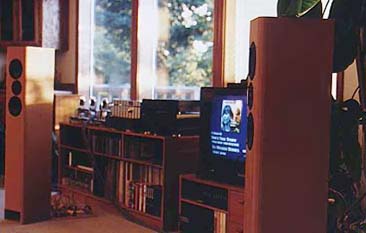
The Amity and Ariels in the summer of 1997

Amity Meets New Friends When I started the Amity project in 1996, it was my first vacuum-tube project. At the time, there wasn't a lot of support for the concept - the SET folks were hard-core believers in their religion, interstage-transformer coupling was much too weird for most Americans to accept (this is the land of the OTL, after all), and the PP-pentode crowd was living back in the Fifties - recycled Williamson, McIntosh, Marantz, and Dyna circuits were the limit of acceptability.
The schematics - and attitude - of the Direct Heating enthusiasts in Japan provided inspiration, along with mid-Thirties schematics of Western Electric theater amplifiers. But I'm not an anachronophile - old is not automatically good. I have no interest in reproducing the limitations of old equipment, which was designed around the restricted bandwidth of mid-Thirties sources. An exact part-for-part copy of a WE amplifier results in an amplifier that can barely make it from 30 Hz to 15kHz, fine for vintage enthusiasts, but not anything that interests me.
What limits the bandwidth of an interstage-coupled amplifier is the IT transformer itself; the bandwidth is a function of transformer design and the source impedance that drives it. Rather than maintain a mid-Thirties retro theme throughout, I selected high-transconductance tubes from the early Sixties Space Age era - 5687, 6900, 7044, and the 7119. These have 1/3 to 1/4 the output impedance of a 6SN7 with comparable - or less - distortion.
At the beginning of the Amity project, interstage transformers were rare, especially well-balanced PP models. Rather than wait years for fashion to catch up with Japanese and American audiophile transformer builders, I discovered off-the-shelf models from Lundahl Transformers, and made the happy discovery that they exceeded specifications, were modestly priced, and sounded as good as any exotic, high-priced model. The fact that Lundhahl has been selling professional-grade transformers into the European studio market for the last thirty years is another plus.
It was mostly the encouragement of Harvey "Gizmo" Rosenberg who made me consider shunt regulation for the input/driver stage, instead of the usual RC filtering favored by the SE and PP folks at the time. Meeting Harvey in person, or talking to him on the phone, was quite different than his crazy-clown persona. That image was for public consumption; for anyone who knew him personally, he was reflective, calm, and powerfully encouraging when it came to trying new approaches to audio. I feel sad he never heard the Amity, although I'm sure my positive descriptions of it led him to review the Sun Audio products, which also use IT-coupling, but with a slightly different (more traditional) design philosophy.
With a lot of assistance from Matt Kamna, the first Amity's came alive in midsummer 1997, and you can see a photo of them above, sitting in my Oregon living room, a bit behind the Left speaker, and beside the Jeff Rowland preamp. Since Kevin Carter was one of the first people to build an Ariel speaker, I told him about the Amity project - in a few months he built his own version, and then picked up the North American distribution of Lundahl transformers! Kevin and his friends have built many different transformer-coupled amplifiers, and the K&K Audio Forum is the best source for information I know of.
Thanks to the original Amity page and the K&K Audio Forum, interstage-coupled amplifiers have entered the DIY scene, although they are still rare on the commercial market. In the last two years, word about the Amity, Raven, and Aurora has spread, and several builders have been kind enough to send me e-mails and photos of their projects.
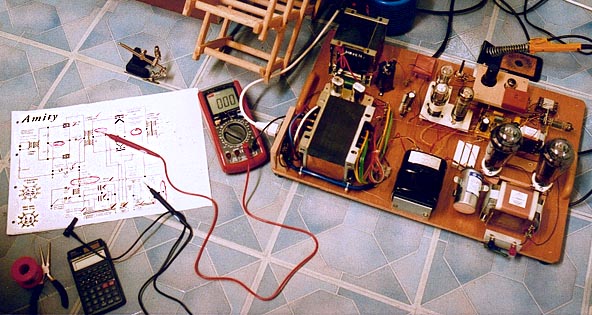
Here's a photo of Mark Jeffs' first Amity, which also incorporates an integral Kimmel mu-stage pre-amp with 6J5 on the bottom and a E180F (Mullard) pentode on the top. So far, one channel only, but here's Mark's sonic impressions so far:
More superb music last night . Got out some Fairport convention - Unhalfbricking; 'Who knows where the time goes', 'Percy's Song' (which I didn't normally rate too highly, but sounded great last night) and 'A Sailor's Life' . Words fail me to describe, particularly the last mentioned; and with only one channel playing.
John Martyn 'The Tumbler', played the whole second side. 'Dusty' and 'Seven Black Roses' stood out, of course. Played it quite loud. Huge, powerful impression of the playing, but the instrument really tonally expanded, glowing. 'Seven Black Roses' really dynamic and urgent, superb.
One track from Island 'Bumpers' collection also stood out. Beginning of 'Little Woman' by Dave Mason. He comes in immedately with a very sharply hit chord on the guitar (metal plectrum or strings?): the transient was RAZOR sharp, cut the air like a knife. I noticed the detail and speed on edges quite a lot last night.
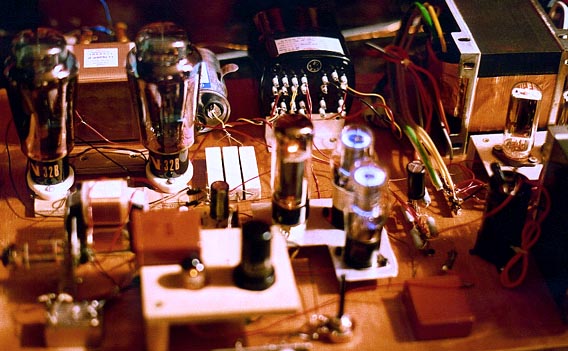
I have no reservations about any aspect of the sound since last night. I think it has gone beyond anything Paul has demonstrated, for example the 212 SE amp, (though his ultimate driver for that circuit hasn't been built yet). I think the start point for the tone is a little different from my SE amp, but the tonal discrimination (and palette) is better and wider. There were more inflections of tone and colour than I'd been aware of before, on every disc I tried. The impression of soundstage is also remarkable for a mono system as well.
Can it get any better?
Yes, I could put a better volume control on there, instead of the cheap carbon track 100K pot I found in a bits box!
There's are few more cheap components in there as well, for example the VV32B cathode resistors, which need to be changed from cheap 'white coffin' wirewounds (as Thorsten calls them) to Caddocks, then perhaps Mills, as you suggested a while back. May also need to up the size of the ultrapath cap on the ECC99 section, which is only 0.33uF at the moment.
In any case, it's probably outperforming everything else in the system and likely to do so for some time. Thanks for pushing the concept and moving things forward on this design. I know it wasn't you alone (Kevin C, Harvey Rosenberg, Sakuma & W.E. spring to mind), but it takes someone to see the bigger picture and write persuasively about it.
Good luck with the Karna, sounds like your man Pimm is helping out on that as well. Don't hurt your back lifting it! I'll post more later, especially when it's running in stereo.
Mark posts in the Tube DIY Forum using the moniker Island Pink, so you can follow his adventures as he completes the second channel and gets to hear the Amity in stereo! Another Tube DIY poster who's built a "Petite Amity" (PP 2A3's instead of 300B's) is Vinyljh - he's over in New York, and is pretty happy with the results.
"Astonishing" that's the only word that comes to mind for Stephen Robinson's Grand Aurora. It's certainly obvious that Stephen doesn't have small animals or children around, with 1000V floating around the exposed chassis! A truly impressive project, with power to spare from mighty PP 813 power tubes. This project was so big, and so massive, it was too heavy to move. So Stephen built it in situ, right in his living room.
His comments on building this amplifier:
- you can sit IN the chassis
- you walk to the other side - don't forget to take your tools
- sometimes the soldering iron lead isn't long enough to get to the other side
His website about this amplifier is worth a read, showing the gradual development of a truly over-the-top amplifier. I have no doubt about the sonics - good tubes and good transformers can't help but sound good. Stephen's Acoustat electrostatic speakers probably sound stunning driven with powerful Class A triodes - and he'll probably enjoy his new 15" Tannoy Monitor Golds even more.
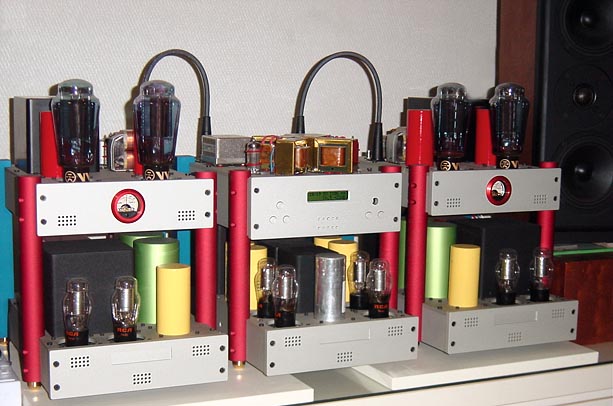
Dr. Hong's Amity and Raven combo have beautiful chassis and design, better than what you see in most high-end stores. The implementation is interesting as well - an upstairs/downstairs approach to the power supply for both the Amity and Raven, and a remote-control volume control! Dr. Hong was kind enough to send an e-mail with his experiences with the Amity and Raven:
Hi,
This is Jae-Min Hong from Korea. I am writing this to share my version of the AMITY and the RAVEN with you and thank you for sharing your great circuits with DIYers like me.
Actually, I must confess that I've been a big fan of your articles. I was totally into it when I first read your article about the Ariel speakers. Although I know few things about the amps and speakers at that time, I decided to make my own speakers at that time. After some studies and considerations, I made my own ME2 speakers. You can see that in the picture I am sending at right corner above the wooden box which is a crossover network for the ME2. This was about 3 years ago.
After that, I found a new article about the amp and the pre amp. The Amity and the Raven. Again this time, I could vaguely understand your article. So I started to study vacuum-tube amplifiers until I could understand every line of your article about the Amity and the Raven. I then started gathering parts and designing the chassis. It took me almost two painful - and joyful - years to finally build it. And the result is what you see here.
Here are my experiences building the amplifiers, along with a bit of explanation of my decisions.
- Separate all Power Supplies: As you can see in the picture, the bottom decks are all power supplies for the Left Amity, Raven and Right Amity. I wanted good isolation of PS noise and good looks as well. This approach does cost more, though. I decided from the beginning, this amp should look good as it sounds. Because I did nothing to the circuit design, I wanted to contribute to the outfit of the amp.
For the placement of the parts: I used my VISIO program for the design of the chassis. Final revision number was 6 and it took me more than a year! One reason for this amount of time is my laziness and my job, but the other reason was the re-re-re-thinkings.
You may notice the parts are placed in a way of the signal flow. This might not be the best way to build one, however, after finish of the amps, I find no hum or noise so far.
I changed a few numbers from your original design, like slightly low B+ values, slightly low B0s as well. But I tried to match up your original design.
Your article was so nice so I could not lost my way in building the amps once I fully understand it.
It was a bit expensive to build one. However, "expensive" and "cheap" are relative words. It WAS expensive for me but for people who spend a few thousand dollars for their cables, it could be nothing.
Remote Control: I wanted to have a handy way to control the amps without standing up and walking to the amps. Yes, I am kind of a lazy bone. However, I didn't want to get rid of the 40-step attenuators. So I bought a servo motor, chains and gears to control the attenuators. I also bought relays, microcomputer, LCD display and IR sensors. With some programmings and trials, I got a infra-red remote-control volume control, channel selectors, power on/offs, sleep controls and even a clock! You can see this on the Raven top deck.
However, I found I need bigger servo motor to have good control of the attanuator because of the big torque from the attenuator. So in a near future, I'd like to go for a bigger one or, go for a primitive and old-fashioned way of control (by hand). Actually, I prefer to go back to the old-fashioned way. Why? I feel that a big tube amp doesn't go with a sleek remote control.
Sounds: Well, this is the last thing I want to discuss here. Reason one: I am not a good reviewer. Reason two: I don't have golden ears. Reason three: I am not a good writer.
I've read articles from reviewers all over the world who are known as "golden ears", with great words and praises. I wonder how they can have full emotions with different words and so on.
I sometimes feel that "words" or "language" are not good tools for communications between people. Sometimes, eye contact, gestures, and even telepathy (I don't fully trust in this though) can communicate more than language.
Likewise, I can not give you words to explain the sounds of my amps. Furthermore, I made it all by myself. So, for me, it is the best sounding machine I have ever heard.
I want to thank you again for your nice design of the amplifiers.
Best regards,
Jae-Min Hong, Ph.D
Optoelectronic Materials Research Center, KIST
P.O.Box 131, Cheongryang, Seoul, Korea 130-650
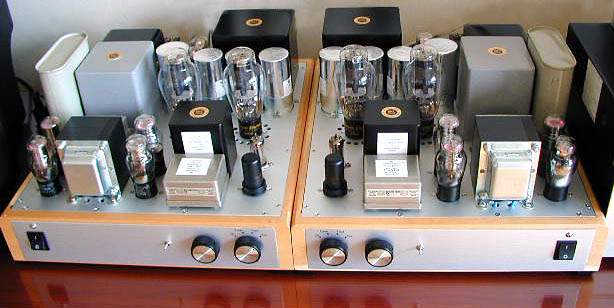
Thanks to mishandling my e-mails, the only information I have about this amplifier is from memory - if you'd like to send more information, please send it to me at:

This is a full-size Aurora, circuit probably similar to the Gary Dahl Aurora, but with different transformers - I'm not sure, but they look like Tamura. The builder has chosen a metal-can (RCA?) 6J5 for the input tube - the Aurora strongly responds to the choice of the input tube, so selecting another one essentially gives you a completely different tonal balance.
I've found that using a 6P5 at the operating points of a 6J5 (10mA, 500 ohm cathode resistor) gives exceptional sound - and 6P5's aren't that expensive, and plug directly into the octal socket of the 6J5 with no modification to the circuit. By the way, the 6P5 is simply an octal version of the five-pin 76 triode, so you can give either a try, depending on the sockets you have on hand. I think you'll like what you hear.
I'd recommend a visit to K&K Audio Forum if you'd like to learn more about all-transformer-coupled amplifiers. This is the single best resource I know for circuits of this kind - everywhere else it's RC-coupling or direct-coupling, and it's an uphill battle to get people talking about transformer coupling.
Amplifier Design Philosophy
© 2004 Lynn Olson.